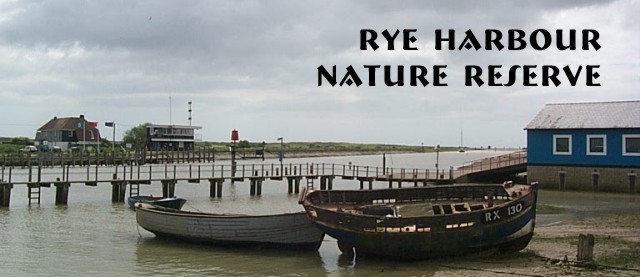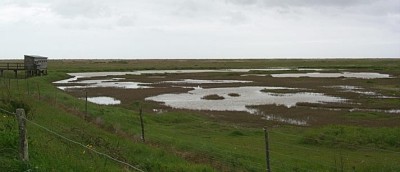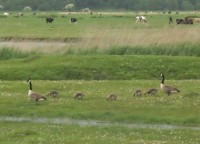
...


... ... 
A closer view of the Wader "Scrape" and hide There was not much variety in the denizens of the scrape, but there were lots of each species, making for much entertainment locating and identifying each one. The Oystercatchers were pretty obvious, but every Redshank had to be confirmed, as did every Ringed Plover (I guess the Little Ringed Plovers stayed at, or were blown back to, Dungeness). A few Herring Gulls taught us the finer points of opening a mollusk. |
| But
the highlight had to be the mating pair of Redshanks! There he was, precariously
perched on her back in the roaring wind. It was never quite clear what
happened, but we think the wind caused her to lose her balance, and she
started to walk into the wind to try to regain her footing. This caused
him to open his wings to retain his balance, and this gave the pair some
lift. She started to run harder to stay with him, and he finally fell off
with a bump as the wind caught his wings. She then left to sue for annulment,
since, as far as we could tell, the marriage never was actually consummated!
.. We finally left the hide, and were re-shocked at the bitterness of the wind. But, we really wanted to get to the Ternery Pools, so we plodded on. Finally we met two returning birders who informed us that there was nothing to be seen along the rest of the trail -- I wasn't surprised. No self-respecting bird should be out of shelter in that wind! We turned our attention to the estuary itself, but when the wind finally blew over our very heavy scope and tripod (good catch, Duncan), we decided enough was enough, and scurried back to the good heater in our car! The Cattle Egret on Castle Water would never be seen by us!.. |
.jpg)
Photo Copyright David Linguard |

|
For the rest of the afternoon, we decided that car birding was the only way to go, so we proceeded to the pools on Pett Levels. Just like the Greylag Geese choosing to breed and raise their goslings at Dungeness on Dengemarsh road, the Canada Geese had selected the Pett Pools for their nursery. We saw at least four families, with about 22 chicks between them, at various locations in the short stretch along the A2089 highway bordering the pools. Black-headed Gulls shared the fields with the cows, while a few Cormorants and a group of 14 Oystercatchers loafed on the shoreline of the ponds. |
| Eurasian Coots and Moorhens were seen both swimming and grazing, and one mother Coot threaded through the reeds with her small flock of red-headed young. And, there were even more Mute Swans to the square foot than we saw at Dungeness. A close inspection of every bird failed to turn up a stray Bewick's or Whooper. Maybe at our next stop??? |
....
Back to Dungeness
RSPB Reserve
|